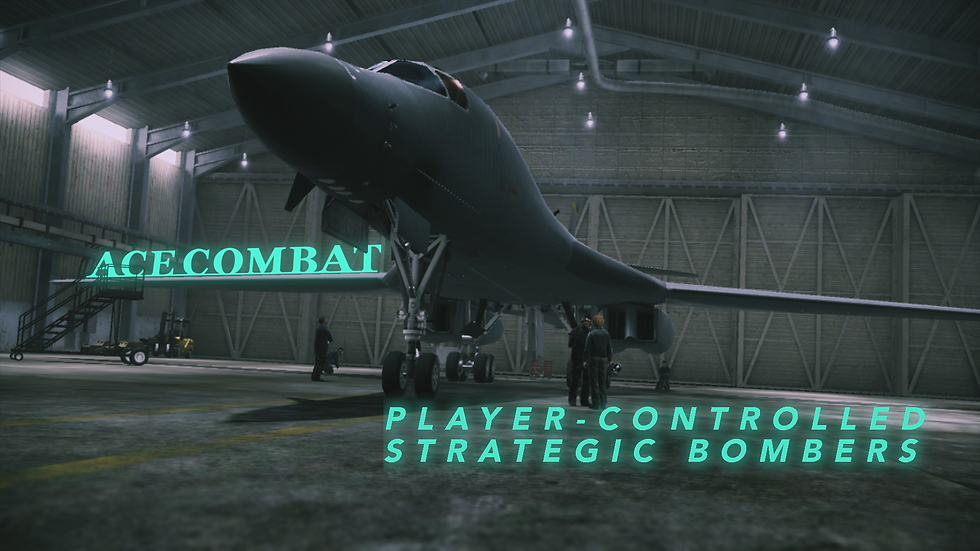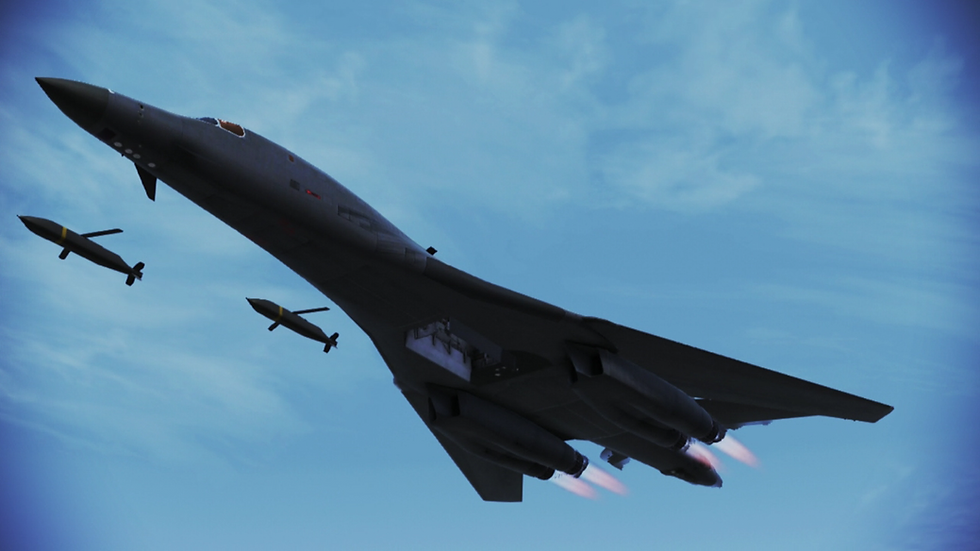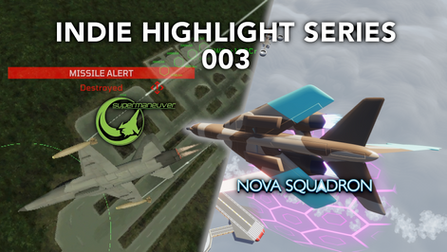Ace Combat: Player-Controlled Strategic Bombers
- Aaron "Ribbon-Blue" Mendoza

- Dec 28, 2022
- 5 min read

To say that 2011 - 2018 was an unusual time for the Ace Combat series would be an understatement. There was an elaborate but failed reboot that included three books and one game, followed by a fantastical mash-up of the real world with elements of Ace Combat's original world for a free-to-play game.
Of the new ideas tried, player-controlled strategic bombers were one of the most eyebrow-raising additions. Players could finally fly bombers themselves. Ace Combat is famous for high-energy, breakneck dogfights and Mach-speed ground attacks with the most popular fixed-wing fighters that do and don't exist. Throughout Ace Combat's now 27-year history, bombers are either easy to shoot down beginner targets, a slow low priority threat or units to be escorted while players zip around the map swatting down interceptors.
Flight Characteristics
Player controlled strategic bombers in Ace Combat benefitted from its arcade flight model. With no G-limits and higher-than-normal speed flight available, flying these aircraft did not feel like the slow, carefully planned endurance missions they were designed for. Even on the Expert control settings that better reflect actual flight controls, players could throw their bombers across the sky without any serious worry but had a limited amount of roll they could use. The bombers were limited to what is referred to as Novice controls, which tie roll and pitch controls together. This made every control input to the left or right a coordinated turn that would not allow bombers to fly inverted or at extreme bank angles. Restrictions on pitch were also in place, not allowing bombers to make full loops.
There wasn't much variety. Only the B-1B Lancer and B-2 Spirit were available in the two Ace Combat titles players could fly them in. In particular, the B-2 was hampered by how the series presented stealth aircraft at the time. With no considerable benefit to stealth capability in either game, the B-2 was somewhat the lesser of the two options. The B-1B enjoyed the added benefit of already being a high-speed platform, with flight arcade physics enhancing its speed and maneuverability. Even a semi-upgraded Lancer could match the speeds of aircraft like the Su-34 and F-15E.
Their most important capability is the overwhelming firepower they can produce in just a few seconds. Putting over a dozen weapons on target in a single pass is something even high-performance multirole aircraft could not match.
Restricted Introduction
In Ace Combat: Assault Horizon (2011), the flagship title of the attempted reboot, player-controlled strategic bombers played a minor role in offline and online gameplay. One single-player mission focused on sneaking past air defense radars and decimating bases. The mission inevitably ended with bravely running from enemy interceptors until allied fighters arrived to save the day.
Example of Ace Combat: Assault Horizon single player gameplay. (2:58)
The same was true in Capital Conquest, a large-scale team-based multiplayer game mode. After a certain threshold, players on the losing team could fly strategic bombers in a last-ditch effort to change the tide of battle by decimating the opposing team's headquarters in a single bombing run. The success rate of these hail-mary bombing runs was low, but when they did get through, it was almost a guaranteed win for the losing side.
Example of Ace Combat: Assault Horizon online bomber gameplay. (1:12)
Assault Horizon's iteration had a limited impact because there were not enough opportunities for players to fly them. Their gameplay relied on Air Strike Mode, a part of this game's cinematic Close Range Assault system made to provide scripted cinematic moments and dynamic camera angles for a Hollywood action-style presentation. But Air Strike Mode (ASM) made players fly in an on-rails-like game mechanic, restraining their maneuverability while in ASM. That's a minor restriction when you know those bombers won't be doing high-G maneuvers anyway, but further limiting their gameplay didn't help make them more appealing.
The Full Experience
Ace Combat Infinity (2014) was a free-to-play entry in the series that boasted the largest aircraft selection of any game in the series. While this game did have an unfinished single-player story, its primary draw was online competitive PVE co-op. Summarizing the game mode, two teams of four players compete against each other to destroy many enemies within a limited time frame. The players on each team cannot shoot each other down, so the winning team was decided by how many points they accumulated by the end. The game also featured an aircraft customization system with performance and weapon effectiveness upgrades.
With the removal of ASM and the option to fly strategic bombers at will, their full potential in Ace Combat was displayed. With no air-to-air weapons onboard, bombers carried two air-to-ground weapons, including unguided bombs, guided bombs, long-range air-to-ground missiles, and stand-off dispensers. The blast radius of each weapon was notably larger than similar weapons carried on fixed-wing and rotary-wing aircraft. A single well-placed munition from a strategic bomber could destroy half a dozen targets. Their longer-ranged weapons had equal blast radii, giving bombers somewhat of a first-strike capability other attackers could not match.
Example of Ace Combat Infinity online gameplay.
While they were useless in dogfighting, Ace Combat's famous massive flying airships were vulnerable to incredibly aggressive bombers willing to drop bombs onto their massive fuselages and wings. A flying aircraft carrier typically needs to be destroyed section by section, with smaller aircraft making multiple passes. A brave bomber could align itself above this massive flying target and bomb them to ruins in less than a minute.
In Retrospect
Beyond some meme-worthy aircraft formations of entire flights of strategic bombers, generally, players used them less than the faster and more maneuverable attackers, fighters, and multirole aircraft. Player-controlled strategic bombers did not return for the release of Ace Combat 7: Skies Unknown (2019), but in retrospect, the reason for this is obvious. They only had success when online multiplayer game modes had more diversity beyond the tried-and-tired obsession with team deathmatch or battle royale. Allegedly these game modes are the only things players care about, which is highly debatable considering how well liked the PVE and PVPVE game modes Ace Combat Infinity were.
Ace Combat Infinity is long gone and completely inaccessible, but the lesson of diverse multiplayer game modes allowing every aircraft under the sun to be somewhat viable has been forgotten. Here's to hoping the next installment in the series finds a way to recapture the magic of a supersonic B-1B slugging its way to victory.

About the Writer
Aaron "Ribbon-Blue" Mendoza

Co-founder of Skyward Flight Media. After founding Electrosphere.info, the first English Ace Combat database, he has been involved in creating flight game-related websites, communities, and events since 2005. He explores past and present flight games and simulators with his extensive collection of game consoles and computers. Read Staff Profile.





































.png)